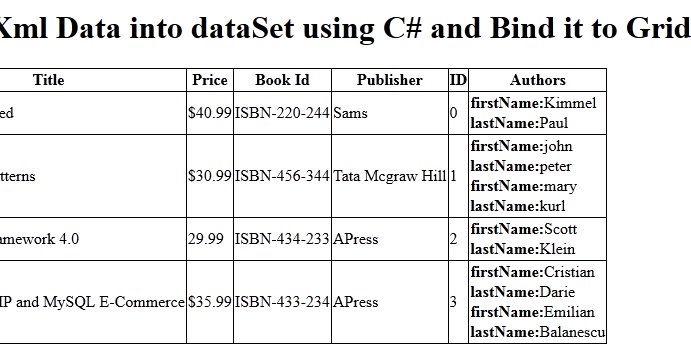How To Read Xml File Into Dataset In Asp.net
Read XML File and bind it to GridView in ASP.Net. In the below code, first the data from the XML file is read into a DataSet using its ReadXml method. Sep 10, 2009. How to read xml into Dataset. I save the result to a local file, but my dataset could not read it. How to Open and read an XML file to Dataset XML is a platform independent language, so the information formatted in XML can be use in any other platforms (Operating. Here in this blog we will see how to first write data from data set into a XML file and then how to read that XML file data into a Dataset.
Loading a DataSet from XML • • 5 minutes to read • Contributors • • • • • • In this article The contents of an ADO.NET can be created from an XML stream or document. In addition, with the.NET Framework you have great flexibility over what information is loaded from XML, and how the schema or relational structure of the is created.

To fill a with data from XML, use the ReadXml method of the object. The ReadXml method reads from a file, a stream, or an XmlReader, and takes as arguments the source of the XML plus an optional XmlReadMode argument. (For more information about the XmlReader, see.) The ReadXml method reads the contents of the XML stream or document and loads the with data. It will also create the relational schema of the depending on the XmlReadMode specified and whether or not a relational schema already exists. The following table describes the options for the XmlReadMode argument. Option Description Auto This is the default.
Examines the XML and chooses the most appropriate option in the following order: - If the XML is a DiffGram, DiffGram is used. - If the contains a schema or the XML contains an inline schema, ReadSchema is used. - If the does not contain a schema and the XML does not contain an inline schema, InferSchema is used. If you know the format of the XML being read, for best performance it is recommended that you set an explicit XmlReadMode, rather than accept the Auto default. ReadSchema Reads any inline schema and loads the data and schema. If the already contains a schema, new tables are added from the inline schema to the existing schema in the. If any tables in the inline schema already exist in the, an exception is thrown.
You will not be able to modify the schema of an existing table using XmlReadMode.ReadSchema. If the does not contain a schema, and there is no inline schema, no data is read. Inline schema can be defined using XML Schema definition language (XSD) schema. For details about writing inline schema as XML Schema, see.
IgnoreSchema Ignores any inline schema and loads the data into the existing schema. Any data that does not match the existing schema is discarded.
If no schema exists in the, no data is loaded. If the data is a DiffGram, IgnoreSchema has the same functionality as DiffGram. InferSchema Ignores any inline schema and infers the schema per the structure of the XML data, then loads the data. If the already contains a schema, the current schema is extended by adding columns to existing tables. Extra tables will not be added if there are not existing tables. An exception is thrown if an inferred table already exists with a different namespace, or if any inferred columns conflict with existing columns. For details about how ReadXmlSchema infers a schema from an XML document, see.
DiffGram Reads a DiffGram and adds the data to the current schema. DiffGram merges new rows with existing rows where the unique identifier values match.
See 'Merging Data from XML' at the end of this topic. For more information about DiffGrams, see. Fragment Continues reading multiple XML fragments until the end of the stream is reached. Fragments that match the schema are appended to the appropriate tables. Fragments that do not match the schema are discarded. Microsoft Office 2010 Activator For X86-x64 - Kms Version -rpt. Note If you pass an XmlReader to ReadXml that is positioned part of the way into an XML document, ReadXml will read to the next element node and will treat that as the root element, reading until the end of the element node only. This does not apply if you specify XmlReadMode.Fragment.
DTD Entities If your XML contains entities defined in a document type definition (DTD) schema, an exception will be thrown if you attempt to load a by passing a file name, stream, or non-validating XmlReader to ReadXml. Instead, you must create an XmlValidatingReader, with EntityHandling set to EntityHandling.ExpandEntities, and pass your XmlValidatingReader to ReadXml. The XmlValidatingReader will expand the entities prior to being read by the.